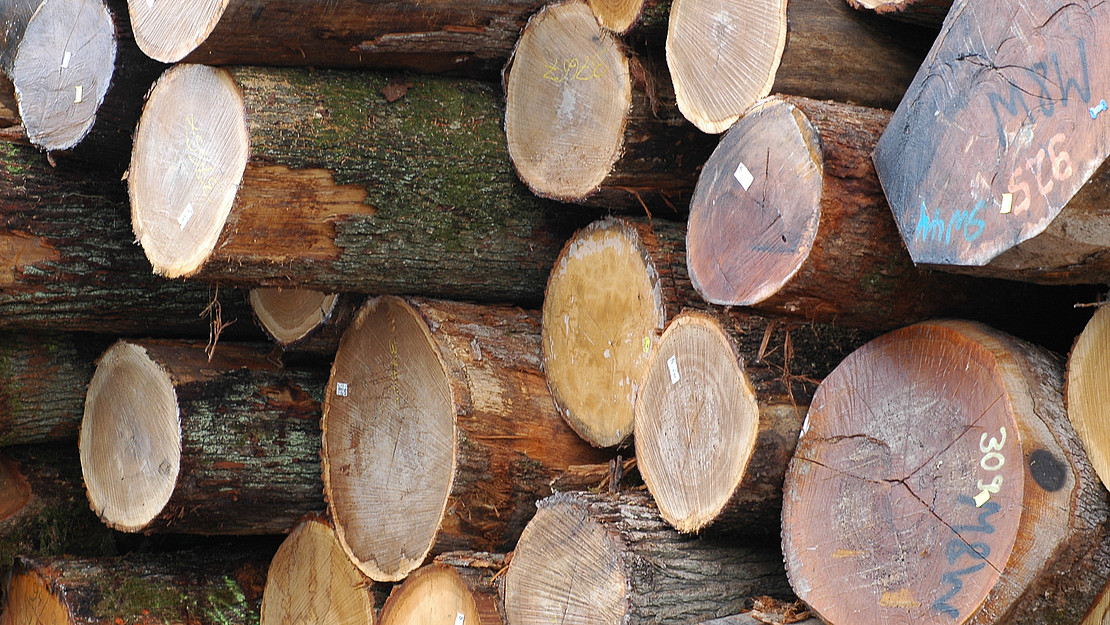This page contains automatically translated content.
On the way to the deforested planet

As a substitute for concrete in building construction, for plastic in packaging and for coal and gas in heating: wood is seen in many areas as a panacea for greater sustainability. In a new study, WWF Germany and the University of Kassel put an end to this myth and show that there is already not enough wood, either in Germany or worldwide, to sustainably meet demand. WWF calls on policymakers to reduce wood consumption and not to automatically consider wood as sustainable, especially in terms of energy use.
This is because the amount of wood harvested worldwide, 4.3 to 5 billion cubic meters (2020), is higher than what can be removed from forests in a sustainable way without endangering forest biodiversity (3 to 4.2 billion cubic meters). Up to 2 billion cubic meters of wood per year are thus taken from the forests too much. This corresponds to about half of all forest trees in Germany. Demand for wood is rising steadily, especially for packaging, the construction industry, bioplastics and bioenergy. The hunger for wood is particularly high in Germany: we consume around 1.2 cubic meters of wood per capita (excluding bark[i]). This is more than twice the global average (about 0.5 cubic meters). The study is based on analyses of satellite imagery, trade flows, and national to global consumption and forest statistics.
"Especially the use of wood for energy, i.e. heating and power generation, is eating a massive hole in forest resources," says Dr. Susanne Winter, forest program manager at WWF. She calls on the EU Commission not to classify the use of wood for energy as sustainable in the EU taxonomy, so as not to make the environmentally harmful practice even more attractive to financial markets. Because according to the study, there is simply too little wood to satisfy the world's hunger for energy. Almost all the world's forests would have to be cut down to meet the world's energy needs for a single year. From the second year on, we would then already have to do without wood to the greatest possible extent, as there would hardly be any usable forests left. Dr. Winter comments: "It is a vicious circle that further destroys the irreplaceable forests. At the moment, industry is using the forest as if there were no tomorrow. If we want to stop climate crisis and species extinction, we need a turnaround in the way we treat our forests now."
"The forest is not a timber factory, it is our livelihood. The study shows how urgently we need a discussion in politics and society about the most sensible use of wood. Harmful subsidies for the use of wood for energy, such as the Renewable Energy Sources Act, need to be reconsidered," Winter said. To bring wood consumption closer to supply, WWF calls for it to be used in a circular and cascading manner. Instead of burning it directly in the power plant or fireplace, it would then first be used for long-lasting purposes, for example as a substitute for the "climate killer" concrete in the construction industry. Winter demands: "For this, the German government must set the legal framework for more recycling management. To support this, investments are needed to build infrastructure, develop know-how and raise awareness of high-quality recycling and the material reuse of wood waste."
Dr. Meghan Beck-O'Brien of the Center for Environmental Systems Research at the University of Kassel says, "Wood can be the raw material of the future. But to keep it from being overexploited, we need to stop the waste we're creating through our business models, incentive systems and social norms. More than ever, this study gives us a reason to look at our lifestyles, the state of forests and climate change in a mutually influencing context." To that end, the study proposes systemic monitoring. It makes the connection between the condition of forests and how, how much and what wood is consumed. Beck-O'Brien says, "Quantity matters, including our consumption of wood. The gap between wood supply and demand continues to grow simply because of population growth. We need to be careful that our insatiable demand for 'sustainable' wood products doesn't lead to even more serious overexploitation of forests, because that comes with major social and environmental risks."
[i] Bark and smaller branches usually don't end up in wood products like furniture. That is why the volume figures for traded or consumed wood in the study are always given without bark. The actual amount harvested in the forest is measured with bark. In order to determine the value, the study adjusted the consumed log volume with respect to the volumes of bark (+12%) and harvest losses (+10%), as well as the origin of the wood outside the forest (-14%). Timber from illegal logging (15-30%) cannot be included due to imprecise data.
Further informationon the study can be found here: wwf.de/all-aus-holz
Contact:
Dr.-Ing. Meghan Beck-O'Brien
University of Kassel
Center for Environmental Systems Research (CESR)
Email: meghan.beck-obrien@uni-kassel.de
Rebecca Gerigk
WWF-Germany, Press Office
Tel: 030 3 11 77 74 28
Mobile: 0151 188 54 833
Mail: rebecca.gerigk@wwf.de